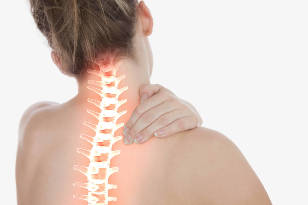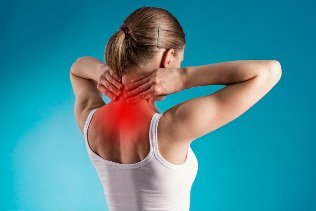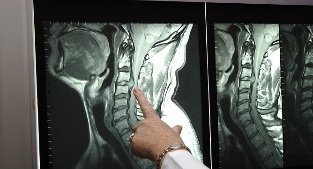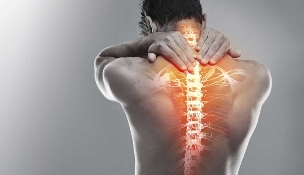The neck osteocondrose — degenerative diseases-degenerative process in the intervertebral discs of the cervical spine, followed by the replacement of cartilage, bone, cloth and immobilizing the vertebrae. According to the statistics of the types of degenerative diseases-degenerative changes in the cervical area, the department of the vertebral column are present in about half of all people under the age of 25 to 45 years of age.

Causes and risk factors
The anatomical features of whiplash will create the background for the development of early degenerative degenerative changes. The vertebrae of the segment of the cervix for different maximum mobility to perform all kinds of movements in their entirety, and because of this they are unaffected by early wear.
For the prevention of degenerative cervical disc disease you should think at an early age.
For the development of the disease, degenerative disc disease of the cervical disc has a sedentary lifestyle, and especially the habit of sitting up, stretching his neck to the front, which increases the pressure on the intervertebral discs, leading to the deformation and dehydration of polosnyj the nucleus. The degeneration of the tissue of the cartilage and to make matters worse, the violation of trophic, by reason of the contraction of the blood vessels spasserovannye muscles. Phase in the production of degenerative cervical disc disease can contribute to the following factors:
- congenital anomalies of the building to the vertebrae;
- diabetes / endocrine disorders;
- auto-immune diseases of the connective tissue (arthritis and systemic lupus erythematosus);
- stiffness in the nape of the neck of the baby.
- the dysplasia of the head of the hip joint;
- flat feet;
- disorders of the posture and curvature of the spine;
- injury and microtrauma cervical vertebrae;
- tobacco use and harmful use of alcohol;
- the long-suffering of mental well-being
- hereditary predisposition.
The development of the disease, degenerative disc disease of the cervical disc is also a contributor to the ongoing poisoning of the body to be in an environment of dysfunctional in the field, regular contact with a harmful substance and the the the availability of of chronic foci of infection in the body.
The symptoms of degenerative cervical disc disease
In the early stages of degenerative diseases-degenerative process of the disease occurs almost without symptoms. The discomfort in the neck, occurring when a sudden movement after a long period of time is the conservation of hard-to sit on the position and the tilt position of the head, or in response to exercise is excessive. The development of myositis that is accompanied by a feeling of stiffness, and in light of the location of the pain-point for cramping in the muscles of the neck.

Excessive neck osteocondrose is characterized by it's persistent, a sore throat, a familiar tension in the muscles and limitation of mobility of the segment and the cervix; the forced position of the head in the part and soothes the discomfort. The curve and the inclination of the head, a lot of times you hear the crunch of bone. Subluxations from the spinal joints, accompanied by acute burning pain, which commonly is a so-called shooting range, and vegetative disorders: dull headache, dizziness, darkening in the eyes, the heart is beating faster, and t. d. Spontaneous reduction nodluxação brings quick relief.
In the case of the formation of the OSteofits and extRusi, the posterior portion of the vertebrae, while the share of the manifestations of the degenerative disc disease of the cervix, later on, they are added to the root symptoms.
- the pain of the head, which is located at the back of the head, and the parietal on the right
- the reduction of the sensitivity of the skin to one side of the neck;
- disturbance of speech and numbness of the tongue;
- discomfort in the area of the outer surface of the shoulder;
- a respiratory disorder.
When you defeat OStEkondrosa the third cervical vertebra, at times, may be a reflection of the KardIlychsky syndrome is pain behind the breastbone radiating to the shoulder blade and the shoulder, which is caused by the association with a heart attack, especially if they are painful, accompanied by a rapid heart palpitations. In the event of failure of the three vertebrae, the lower the sensation of pain and paresthesia, are distributed on the neck of the knife, the arm, the brush of fingers. Patients may complain about numbness of the limbs, a burning sensation, "pins and needles", or the "place" in the course of the nerve.
For the development of the disease, degenerative disc disease of the cervical disc has a sedentary lifestyle, and especially the habit of sitting up, stretching his neck to the front.
OSteofits, which are located on the lateral surfaces of the vertebrae, comdallywayt anterior spinal artery, leading to a complex of disorders in the cerebral circulation, which is called the syndrome of the anterior spinal artery. This pathology is manifest if frequent bouts of dAvada, pain in the head, which is provided with a neck at the top of the head, and the whiskey, giving one in the eye. In some cases, because of the pain in the head, is held constant, feeling of heaviness in the head. Simultaneously occurs, the autonomic symptoms, such as:
- changes in the blood pressure;
- the heart attack, and irregular heartbeat;
- the enxaquecanoda DEAse of a unilateral throbbing headache accompanied by photophobia, nausea, and vomiting;
- violation of thermoregulation (shivering, sweating, cold extremities);
- dizziness, fainting and drop attacks;
- - infringement of coordination of movements;
- the noise and congestion of the ears;
- the decrease in visual acuity, and visual disturbances: the darkening, and diplopia, paratumanitarie-of-sight, flash, and colorful front view of the front of the eye;
- sleep disorders;
- the increase in the fatigue and emotional lability.
The diagnosis
Due to the low specificity of symptoms and a wide range of manifestations, a diagnosis of degenerative cervical disc disease is performed in several steps. Start with a consultation with a specialist, a surgeon, an orthopedist, a neurologist, or vertpedido for now. A presumptive diagnosis it is based on the patient's complaints, anamnecomtICHecomfir of the data and the results of the survey. During the evaluation of the patient, the doctor draws attention to the mobility of the neck, skin sensitivity, and pain in the cervical area of the segment and the shoulder strap of the seat belt, the force and tone of a muscle, the severity of the tendon reflexes.

In order to determine the stage of a disease process, and detection of complications on the patient's use in a magnetic resonance imaging of the cervical spine. The quality of the visualization of solids and of the soft tissues in the tologramma well-displayed all of the symptoms of degenerative cervical disc disease – a reduction in the height of the intervertebral disc, OSteofits, sobretda, Georgia, extrusion, damage to the nerves and blood-vessels, calcification of ligaments, pockets, bone resorption, miozits, and the stagnation of the processes in your body.
Doing jobs around the house, it is not possible to stay on the cutting edge of the feet, or keep your hands raised above your head, it's better to use the stairs, or go on a low stool.
In the case of non-availability of mri scans carried out x-ray or ct scan of the segment of the cervix for the purpose of identifying the OSteofits, OSteoartrosass and a decrease in bone density. The changes of the soft tissues are visualized with the aid of ultra-sound for the hemodynamic study, and the assessment of the extent of the damage to the blood vessels for the implementation of cervical osteocondrose is required ddopplerografii of the vessels of the neck, and when there is a suspicion of a violation of the spinal cord – a sharp contrast to the myelography.
In the treatment of degenerative cervical disc disease
Osteocondrose of the cervical spine requires a comprehensive treatment. During an exacerbation, the primary task of the therapy is reduced in order to alleviate the pain, and the relief of the inflammatory process and in the reconstruction of the capillaries in the blood circulation in the affected area. Patients are prescribed pain-killers or anti-inflammatory agents, non-fund, both of which are better inhibitors of cyclo-oxygenase-1 is based on diclofenac, and nimesulide. When expressed in muscle spasms, we recommend that you use one of the, if necessary, to prescribe antispasmodics, and muscle relaxants.
When a radicular pain syndromes with a poor response to treatment for the drug use of an x-ray-controlled, the locks, the disadvantaged, the root of the nerve, and the injection of steroids. To improve the metabolism in the intervertebral discs and damage to structures of the nerve shows the exchange rate of the intake of the vitamins of the group. Hard-to-extrusion, the violation of the spinal cord, and refractory pain that is caused is the purpose of the indications for surgery.
For the complete recovery of the intervertebral disc when the osteocondrose it's unlikely, but with the help of timely and adequate therapeutic measures, you can stop or slow the progression of degenerative diseases-degenerative process.
At least, the alleviation of the acute symptoms begin a course of physical therapy aimed at activation of the blood supply at the injury sites, and the recycling of the products of inflammation. Well-established, electrophoresis and phonophoresis, magnetic therapy, amplipuls-therapy of shock-the place for therapy, UHF, and diadynamic.
The rapid recovery of mobility to the cervical spine can contribute to the classroom in groups, therapy, exercise, swimming and Aqua fit classes. To practice at home, in the exercises is most effective when the cervix osteocondrose does not require the use of special equipment, and simulators. The diary of a rehabilitation programme, estimated at between 15 and 20 minutes, and consists of five simple exercises. All of the exercises are repeated 5 times at a slow pace, the gentle, gradually increasing the number of trials up to 10-to 12-fold.
- The twisting and rotation of the head to the right and to the left, keeping the same position of the head and the shoulders.
- The alternate pressure on his forehead and the back of her head in the palm of your hand with a little bit of tension in the muscles of the neck.
- A tilt of the head, the upturned behind, at the jugular vein fovea and out to the side. When tilted to the right, you need to touch the ear to the right shoulder and the left and right ear to his left shoulder.
- Pressure in the left temple, in the palm of his left hand, then right hand to the temple, in the palm of his right hand.
- The angle of the jaw to the neck, turn your head to the right or to the left.
The funds of the people, and the medicine is non-standard it needs to be handled with great care, and to coordinate their implementation with your doctor. In the absence of contraindications, you can go for a course in reflexology, osteopathy and hirudotherapy; - the chiropractic treatment is strictly not recommended. Of a regular massage treatment, when the cervix osteocondrose gives the most promising results, does not expose the patient to unnecessary risk.
The potential for complications and side effects

In the region of the neck, the concentrate of a great number of vegetative nerve plexus and the blood vessels, including the vertebral artery and vertebral nerve. The joints that connect the speakers to the front edges of the vertebrae, tend to be strains, sprains, and nodentorses, triangular-shaped intervertebral holes, is in a three-neck bottom to the vertebrae, increase the likelihood that the infringement of the nerve roots by bone, permissions, and spasserovannye in muscles. As a result, the risk of entering the compression syndrome when the neck osteocondrose above, with the defeat of the other functions of the spinal cord.
In the early stages of the disease, the complications are mainly related to the myositis, and muscle spasms. The syndrome of the front of the ladder, the muscle that stretches along the compression of the handle of the plexus nerve and subclavian artery spazmirovannah in front of the stairs of the muscle. The reflex irritation of vegetative nervous fibres, and a lack of blood supply to the muscle tissue is manifested, is contributing to the pain in the forearm and hand, which increases with the angle of the head, and the assurance of his hand. When the displacement of a number of large vessels, is observed in a wavelength from the cold, and swelling of the extremities.
The onset of extrusion, and bone spurs is accompanied by radicular pain syndromes, which, in turn, can be complicated, in violation of the spinal cord. The compression of the spinal cord, and often becomes the cause of paralysis of the upper extremities, and in severe cases it is fatal, due to the increased oppression of breathing. Heavy syndrome of the anterior spinal artery, passing into the middle of the express profile, and excessive neurocirculatory disorder, threatens to become an handicap, and that increases the risk of ischemic stroke, and ischemia of the spinal cord.
Forecast
For the complete recovery of the intervertebral disc when the osteocondrose it's unlikely, but with the help of timely and adequate therapeutic measures, you can stop or slow the progression of degenerative diseases-degenerative diseases of the procedure, avoid complications, and to maximize the preservation of the mobility of the cervix. During the execution of the osteocondrose of the cervical spine, complicated, multiple of the extrusion, and the compression conditions, and the forecast more carefully.
Prevention
For the prevention of degenerative cervical disc disease you should think at an early age. The formation of a correct posture, consistent with the strengthening of the muscle corset back and a healthy diet can help you maintain the health of the spinal column in the adult. When you identify that your child has a disturbance of a posture, the legs flat, and the consequences of a generic injury such as stiffness in the nape of the neck, or in dysplasia of the head to the hips, one should not neglect the rehabilitation program: many of the pathologies of the musculoskeletal system, and puts up with an employee osteochondrosis, and with success, to heal until ossification of the skeleton.

If the trade or business of the patient to assume a sedentary lifestyle, you need to choose an ergonomic office chair, with the support of the neck, and on the ground than a mattress with a pillow-top mattress, and in a low, firm pillow. Sleeping on the couches and beds are screened with mesh is not recommended; it is better to choose a model with a moderately hard, with a smooth surface. While working through each and every 45-60 minutes, preferably, carry out exercises for the neck, and at leisure, to practice physical exercises, and most of the sightseeing on foot. A good effect is to take swimming lessons and aqua-aerobics, yoga, qigong, and pilates classes; power cord (s) and disorder in sports it is better to delete it. During the class, you should avoid sudden movements and keep his back to be exact. Doing jobs around the house, it is not possible to stay on the cutting edge of the feet, or keep your hands raised above your head, it's better to use the stairs, or go on a low stool. Two or three times a year, it will not prevent you to go through a course of medical and preventive massage for the cervical neck area.
The diet should be enough protein, vitamins and minerals, whenever possible, you should include it in the menu, the jelly filling of fish and other seafood – a natural source of collagen. The exemption of the bad habits and help you to maintain an active circulation in the intervertebral disks.

















































